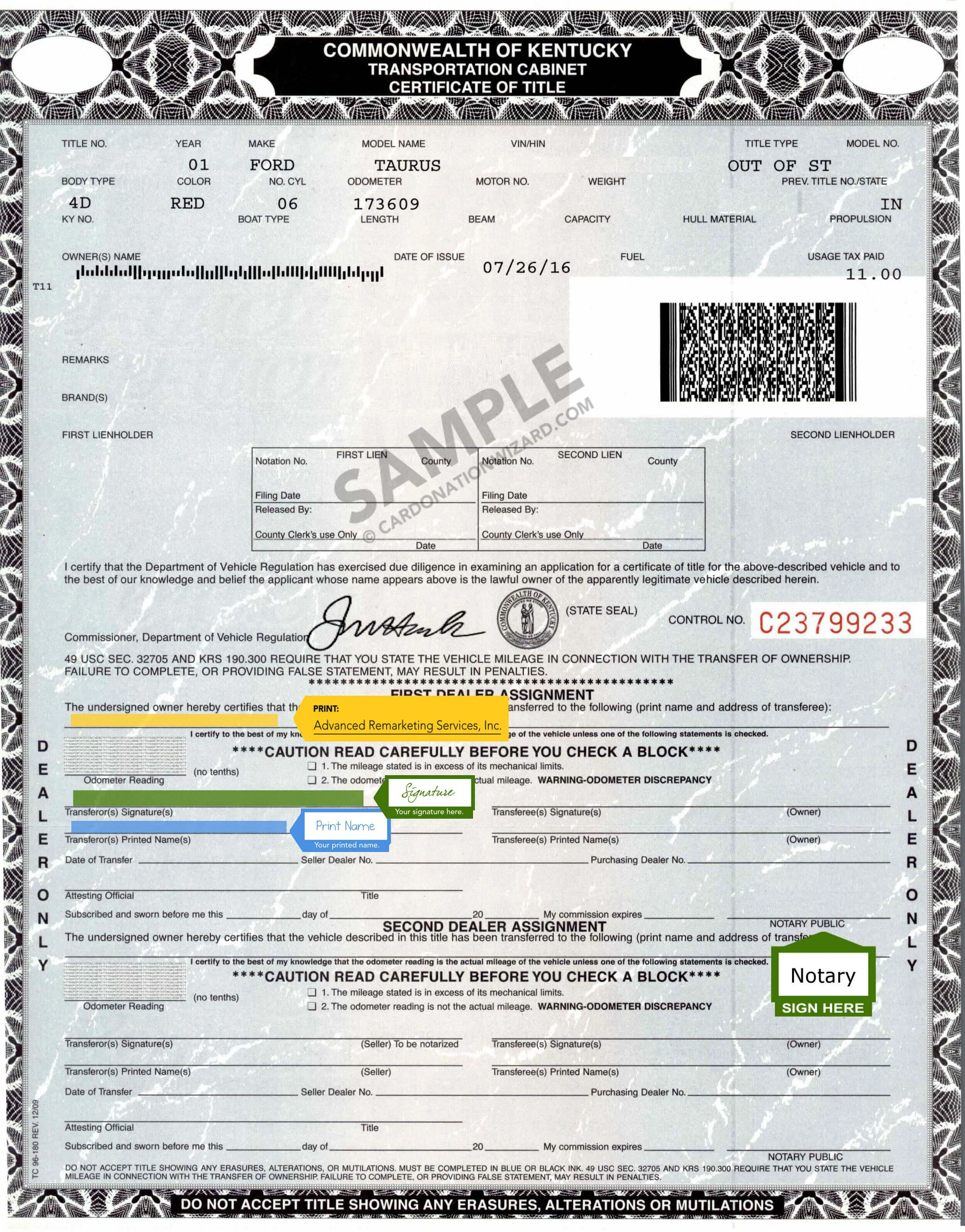Transferring a car title isn’t meant to be a difficult process, but for many reasons the transaction doesn’t always go as planned. Whether you need to change the name on your title or you find a mistake somewhere on it, we’ve got the solutions to the most common title issues we have encountered over several decades of combined vehicle title experience.
While you might catch us saying “cars” at times, this article applies to cars, trucks, vans, motorcycles, dirt bikes, and just about anything else that carries a state-issued vehicle title.
Without further ado, let’s look at the 8 most popular title issues and some tips on how to resolve them. Just remember, if you get yourself into a serious bind you need to consult an attorney and/or the DMV guidelines which are different for every state. We are not attorneys and this article is not legal advice. If you need a new title, registration, or license plates, consider our services.
1. Mistakes on a Car Title Cannot Be Crossed Out
It’s best to leave mistakes alone – trying to erase something or using correction fluid will automatically void your car’s title. Instead, take your title to the DMV to have the error corrected. Luckily, you can easily fix this yourself. When you submit for a new title, you’ll want to make sure that you provide the incorrect one with your documentation.
2. Damaged Car Titles are Usually No Good
It’s always possible to void your car title as a result of a simple accident. When you go to sell your vehicle, you cannot turn over a damaged title, be that incorrect markings, water damage, or rips and tears. You want a flawless certificate so the transaction goes as smoothly as possible.
The best thing you can do is fix the problem before selling. Apply for a duplicate title before attempting to sell the car – if you want to skip the line and the hassle, we can do it for you.
3. What if the Wrong Person Signed Your Title?
When you go to sell a vehicle, there are any number of reasons that someone might back out at the last minute. It’s possible that you all signed the title and were ready to transfer it when everything fell apart, or perhaps you received the title with another buyer’s name on it.
In any case, that title is now null and void. You must go to your local DMV and register for a new title. Of course, you’ll have to fill out the appropriate paperwork and pay the fees, but you won’t be able to sell the car until that happens.
4. What if You Never Transferred the Title Into Your Name?
First, we are going to say tsk tsk! Not only is this a bad practice to get into, but it’s illegal. Floating a title might seem like it’s not a big deal, but there are many consequences to it that you don’t want to face.
As soon as you realize your name is not on the title, you need to have it corrected. Do yourself and the next person buying the car a favor and take care of this before attempting to sell. Thankfully, this is a process you can easily do yourself without any help.
Another note: If you are planning to buy a vehicle and notice the seller’s name isn’t correct on the title, you need to walk away. Otherwise, you should be prepared to deal with a scammer and this should serve as a big red flag. If you are determined to purchase the car anyway, have the seller get a replacement title in their name before proceeding – it’s a lot easier to have them do it than to do it yourself later on.
5. What if Critical Information on the Title Is Wrong?
In some states, to correct written errors on a title you want to draw a line through what’s incorrect and write in the correct information. You should then produce a short statement explaining the reason behind the correction, have it notarized, and give it to the DMV along with the title in question so they can produce an accurate title. In other states, the DMV must make the correction with you present.
More extreme cases will require a new title to be printed, like a misprint of the car’s VIN or model name. Take your title to the DMV and fill out any paperwork they give you for a duplicate title. They will take the voided title from you and issue a new one.
6. Can the Mileage on a Title Be Corrected?
Some odometer discrepancies don’t matter as much as you might think, but if you have reason to get one corrected, simply head to the DMV and have them correct the issue. If, however, the issue stems from when you purchased the vehicle, perhaps because of a broken odometer, then the seller will need to fill out an amended odometer statement – check your state’s DMV website for that.
7. What if You Lost Your Car Title?
This is one of the most common title issues, so don’t feel bad if it happens to you. Thankfully, it is a simple fix that only requires you to register for a new one with your local DMV. Or if you prefer to skip the line and the hassle, we can do it for you.
8. Does a Duplicate Title Void the Original Title?
Yes! Once you receive your duplicate title, your original title is now void. Whether that title was stolen, destroyed or lost, you won’t be able to use the original title again. Your duplicate title is clearly marked in the system so the DMV knows it isn’t the original.
Trust me when I tell you that it’s always best to destroy the original title if you find it later on. You don’t want to deal with the headaches I did after buying a car that had a duplicate title because of this mistake. Had the seller given me the newest title, everything would have been just fine, but he didn’t – and then he promptly disappeared. My only choice was to purchase a bonded title which was a risk in itself.
Most Issues Boil Down to These 3 Problems
In addition to the concerns listed above, there are three extremely common situations that can lead to title problems down the road.
1. The buyer or seller puts their name in the wrong section.
This occurs more often than you would think and requires a new title be issued. Thankfully, that’s easier than most people think.
2. Someone forgets to sign their name at all.
Contact the seller and try to get their signature. If that doesn’t work and you don’t have a bill of sale or some other proof that you bought the car, consider talking to an attorney.
3. The seller forgets the lien release.
This often happens when the seller finances the purchase or the buyer assumes the seller’s active loan. It’s also possible for either the seller or buyer to record information in the lien section by mistake. Either way, the DMV can correct the problem for you. Document your communications with the seller because transferring a title without disclosing an active lien is illegal.
Quick and Easy Ways to Avoid Problems
There are some steps you can follow regarding your car title that will further protect you. First, make sure you store your title in a safe place. It should never be left in your car. We always recommend a fireproof and waterproof security box or safe.
When selling or buying your vehicle, make sure you fill out everything carefully. You want to use blue or black ink and ensure that all the information gets placed in the appropriate spots. Your state’s DMV website should have a guide for filling out titles in your state.
If you are purchasing a vehicle, make sure you run the VIN through a detailed VIN check. This will tell you the owner’s information, confirm that the car isn’t stolen, and let you know if there are any liens or previous repairs that you should know about.
Do you have any experience with these common title issues? If you have ever made mistakes with your title, we would love to hear about it (don’t worry, we’ve all been there!). Tell us what went wrong and how you corrected it in the comments section below so everyone can learn from your experience.
If you need to get a new title for your vehicle, let us do the work for you. We can obtain a new title and registration for cars, motorcycles, and almost anything with wheels. We also offer VIN Checks to help you gather the facts before buying or selling a vehicle. Click the links to learn more about our services.
We are not attorneys. This article is not legal advice. Cover image source

















Technically, a bonded title is considered to be a provisional document. Some states allow the bonded title to be challenged up to several years after the issue date, so if there is any chance you don’t own the vehicle outright, you need to know how long that window is in your state.